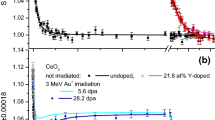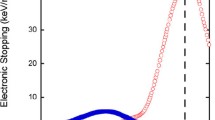Abstract
Nuclear fuels containing uranium oxide, plus fission and activation products, will continue to undergo radioactive decay and also fission after removal from the reactor. These nuclear materials will undergo exposure to heat and persistent irradiation by alpha particles and neutrons. Vacancies and larger open volume defects, sometimes filled by helium, may be created and lead to swelling. Positron annihilation Doppler Broadening spectroscopy was implemented to investigate damage due to 1 MeV Kr-ion irradiation of UO2 and 3 MeV Au irradiation of CeO2 (a surrogate for UO2) and lanthanide-doped versions of these materials. Contrary to expectation, significant differences arose due to the doping atoms. In UO2, the doping atom type resulted in varying concentrations of the same type of defect. In CeO2, the defect type and concentration changed due to irradiation of differently doped material.
Graphical abstract
Comparison of TRIM calculations to positron annihilation spectroscopy Doppler Broadening (PAS-DB) data vacancy signal S (both left axis) and PAS-DB of irradiated CeO2 (right axis). The UO2 sample was irradiated with 1 MeV Kr ions and the CeO2 sample with 3 MeV Au ions. The solid lines are the simulation of positron data (grey for UO2 from two differently prepared samples and green for CeO2) based on best fits of simple damage profiles (red). The damage profile assumes stacks of layers with constant damage. In UO2, the best fit damage shows layers of decreasing defect concentration (red). In contrast, in CeO2, the damage is low near the surface and rises. These differences may have implications for the use of CeO2 as simple non-radioactive analogue of UO2-based nuclear fuels.



Similar content being viewed by others
Data availability
The datasets generated during and/or analysed during the current study are available from the corresponding author on reasonable request.
References
M.H. Weber et al., MRS Adv. 6, 119–124 (2021)
M.-F. Barthe et al., Phys. Stat. Sol (c) 4, 3627–3632 (2007)
R. Mohun et al., Acta Mater. 164, 512–519 (2019)
L. He et al., J. Nucl. Mater. 496, 242–250 (2017)
P.J. Schultz, K.G. Lynn, Rev. Mod. Phys. 60, 701–779 (1988)
F. Tuomisto, I. Makkonen, Rev. Mod. Phys. 85, 1583–1631 (2013)
J.T. Reiser et al., J. Nucl. Mater. 490, 75–84 (2017)
K. Xu et al., J. Nucl. Mater. 526, 151774 (2019)
K.R. Lund et al., J. Nucl. Mater. 466, 343–350 (2015)
T.A. Olds et al., J. Nucl. Mater. 530, 151959 (2020)
Karcher, S.E., WSU, Materials Science and Engineering, PhD (2021).
A. van Veen et al., Appl. Surf. Sci. 85, 216–224 (1995)
H. Schut et al., J. Appl. Phys. 70, 3003–3006 (1991)
D. Roudil et al., J. Nucl. Mater. 420, 63–68 (2012)
J. Wiktor et al., J. Phys. Condens. Matter 29, 035503 (2017)
M.-F. Barthe et al., Mater. Sci. Forum 445–446, 48–50 (2004)
J.F. Ziegler, M.D. Ziegler, J.P. Biersack, Nucl. Instrum. Meth. Phys. Res. B 268, 1818–1823 (2010)
T. Montini et al., Chem. Rev. 116, 5987–6041 (2016)
L. Li et al., The J. of Phys. Chem. A 115, 7972–7977 (2011)
Acknowledgments
Marc H. Weber, J. S. McCloy, and S. E. Karcher thank the Institute for Materials Research and U.S. Department of Energy Nuclear Energy University Program, Used Nuclear Fuel Disposition program, Award #DE-NE0008689. J. S. McCloy thanks the US-UK Fulbright Commission, and J. S. McCloy and S. E. Karcher thank the S.Y. Chung Centenary Fellowship for support during the research period. R. Mohun and C. L. Corkhill thank Engineering and Physical Sciences Research Council, under the UK-US Nuclear Energy University Program (Grant No. EP/R006075/1), an Early Career Research Fellowship awarded to C. L. Corkhill (Grant No. EP/N017870/1), and the MIDAS Facility, at the University of Sheffield, established with support from the UK Department of Energy and Climate Change.
Author information
Authors and Affiliations
Corresponding author
Ethics declarations
Conflict of interest
On behalf of all authors, the corresponding author states that there is no conflict of interest.
Rights and permissions
About this article
Cite this article
Weber, M.H., McCloy, J.S., Halverson, C.R. et al. Characterization of vacancy type defects in irradiated UO2 and CeO2. MRS Advances 7, 123–127 (2022). https://doi.org/10.1557/s43580-022-00213-6
Received:
Accepted:
Published:
Issue Date:
DOI: https://doi.org/10.1557/s43580-022-00213-6




